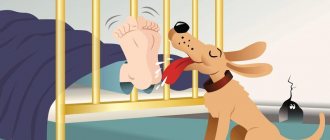Socialization: meeting other people and dogs at the walking area
Teach your dog to socialize so that it is not afraid of other animals and people. The pet should feel confident in society. Socialization rules:
- Take your dog outside for several days so that he can explore the area at a distance of 30 m from the house.
- After 3 days, increase the walking radius, but do not allow your dog to come into contact with other animals and people. Walk near roads so that your four-legged friend gets used to the sounds of cars.
- After two weeks, go to a dog park. But choose a quiet place, so that there are no animals or people. Let your dog look at other pets from afar. Do this for several days.
- In the third week, walk along regular roads in a park or city so that your pet can better familiarize himself with the environment and understand that he is not in danger. If the dog is afraid, then play a ball with him so that he is distracted from strangers.
- After another week, introduce the dog to local packs. Go for a walk with other people who also walk their dogs. Let your pet have close contact with them: sniff, examine, play.
- Take your animal for a ride in a car with people. The dog will immediately get used to the noise and proximity of a stranger. Walk around the market and other crowded places.
Socialization will take about a month. Each dog gets used to it differently, it depends on its character. Do not let all passers-by pet your pet, otherwise he will become very accustomed to people and lose his qualities as a guard dog. Don't overdo socialization.
Toy terrier is afraid of other dogs
- Remember that going outside for the first time is a kind of stress for a dog. Therefore, if you notice that your toy terrier is afraid of other dogs, pick him up. This way he will feel more confident and quickly get used to the atmosphere of the street.
Understands stress for the first time
- Gradually he will run more and more on his own, and this will be a good time to start meeting other dogs.
- The main thing is to start friendships with small and non-aggressive dogs, praise him for every sniff and play. And remember, you can’t raise a dog without patience and affection.
Controlling the situation when the dog shows fear
If you are walking and your dog sees a car driving along the road and starts hiding behind you with his tail between his legs, then go around the vehicle and hold for about a minute, maybe a little longer. The dog will understand that it cannot always hide behind its owner's back. And holding will help the pet get used to unfamiliar things.
But don't go too hard. If the animal has been standing for some time and is struggling and whining, then you should not continue to do this. Otherwise, the dog will experience extreme stress and will take a long time to recover from such an incident.
Do the same if another dog runs up to your dog, or if there is a person nearby. Don't let your pet hide behind your back. Hold him with your hands and let him get used to those around him. But act according to the situation. If someone else's animal is aggressive, do not put your friend in danger.
Muzzle and ears
Your baby's eyes, mouth and ears may indicate fear or fright. So, whitish eyes are a sure sign of nervousness, fear or tension. The same must be said about smaller or narrowed eyes. A puppy who avoids eye contact with its owner is most likely afraid (including possible punishment). Sometimes puppies retract their lips so much that the entire row of teeth is visible. The reason is strong fear. Occasionally you can observe the tongue moving in the mouth, which also indicates fear or tension. The baby’s ears will tell the owner a lot of interesting things: the more they are pressed to the head, the stronger the fear or apprehension.
Don't encourage fear
The noise of cars, loud noises, and barking from other dogs make your pet tuck its tail and hide behind you. If in this case you calm him down, stroke him and talk kindly, then you shouldn’t do that. The animal will constantly sense danger and hide behind its owner. The panic will only intensify.
Don't yell loudly at your dog if he's scared of something. And even more so, you can’t beat a pet. Animals remember the insult for a long time, and will no longer treat their owners loyally. The dog will not understand why he is being scolded. He will simply be afraid of you. Do not encourage fear in any form - it will break the dog’s psyche.
Yorkie is afraid of other dogs
- Often, owners of small dogs limit their communication with other dogs for fear that the baby may be offended. Dogs sense the mood of their owners , and this fear could be passed on to them.
- Therefore, do not be afraid to take your pet to visit those you know who have calm, adequate dogs, regardless of their size. And remember that the Yorkie, despite its size, is still a terrier, which means it is not a pocket dog.
Toddlers may be afraid
- He is a hunter by nature, which means he can easily find a common language with Fox or Airedale Terriers. The main thing is not to be afraid yourself and thereby you will not give a reason for your Yorkie to be afraid of other dogs.
Behavior correction on your own or with a canine instructor
According to experts, dogs become cowardly due to poor genetics. To correct the situation, you will have to get serious about raising the dog or send it to a dog handler for training. But not all localities have dog trainers. Then you need to train yourself. Some examples of behavior correction:
- Take a stick and stand in front of the dog. If she has her tail between her legs and is afraid, then take the cookie out of your pocket and bring the treat to the stick. The animal will be interested in the cookies, and will not react so timidly to the pole. Approach your pet with a stick and cookies and feed it. At this moment, place a pole on the ground nearby. In a couple of weeks the dog will no longer be afraid of sticks.
- If your pet is afraid of sounds, for example, a vacuum cleaner or hair dryer, then go into the room with the dog, close yourself and prepare cookies, but do not show the dog a treat. Have an assistant knock on the door. Your four-legged friend will become wary or scared and try to run away. But you keep it. At the moment of hitting the door, show the animal a treat, it will be distracted from the loud sounds. In the future, experiment with a vacuum cleaner. Bring the matter to a point where the dog is not afraid to be near a working device.
Identify all of your dog's phobias and train him until he begins to ignore his fears. You will spend a lot of time, but it is worth it, because the dog must protect the owner, not the dog’s owner.
- Author: Elena Romanenko
Rate this article:
- 5
- 4
- 3
- 2
- 1
(9 votes, average: 2.9 out of 5)
Share with your friends!
Answer
The age of a puppy at two and a half months is the most acceptable for separation from its mother and moving to a new territory. The strengthened puppy has learned his mother’s lessons on adapting to canine society and is ready to accept the world. A two-month-old animal has already formed a nervous system. He psychologically shows affection for the new owner and begins to accompany him everywhere, just like his mother used to do. Initially, the baby yearns for his mother and fellow tribesmen. He does not sleep in an unusual place, whines, howls. He is scared and unusual. This is how the dog calls its parent.
Causes of fearfulness:
- Genetic. If a mother is fearful, the heredity is passed on to her offspring. When fears have a genetic predisposition and persist at three to four months, they will remain throughout the dog's life.
- Failure to comply with socialization measures. The dog must complete this journey before the age of three months.
- Experienced a stressful situation in the past. For example, I was afraid of loud noises. The dog associates foreign stimuli with danger.
- Weak nervous system. The basis of cowardice is excessive sensitivity. When an ordinary dog reacts adequately to barking, for a cowardly dog a similar case will be the beginning of the development of phobias. Such a deviation cannot be cured. The nervous system is partially strengthened by the correct approach to introducing the puppy to society.
How to teach a dog any skills
A German Shepherd puppy must first be raised with love and care, and then begin training. Desired skills must be reinforced, and for misdeeds scolded, but not beaten. It often happens that a young German shepherd snapped at someone in the family, and the owner was touched by this: this is what a “proper” angry dog is. This cannot be allowed.
The animal should not show aggression towards family members, especially if you want to raise a guard.
A sharp “Ugh” immediately after the action and a light spank, but not a spanking, will show the dog that this is unacceptable.
Encouragement of some action for an animal - affection or something tasty. Teach your pet to follow general commands first:
- "To me";
- "Sit";
- "Near";
- "Ugh".
A general training course is required before training in protective guard service. You cannot “harass” a puppy at a young age, otherwise you will end up with an uncontrollable monster. An adequate and obedient animal, in which guard qualities are inherent by nature, will itself begin to protect its owners and guard the house.
When does a German Shepherd puppy start barking at strangers?
The good-natured disposition of a German Shepherd should not confuse the owner if the animal is not yet 6 months old. The joyful puppy does not bark at strangers yet only because of his age. The first signs of a guard dog may appear at six months or a little later. An experienced instructor will tell you at what age to start instilling watchdog qualities in your German Shepherd puppy. As a rule, we are talking about 9-12 months. If you start training your dog too early, there is a high chance of breaking his psyche. And what an uncontrollable aggressive German Shepherd is, it’s better not to know at all.
If you want to raise a dog who is distrustful of strangers, then during puppyhood you should keep him from communicating with strangers, but this must be done subtly. You can’t shout “Ew” to a puppy if he starts playing with a person, just switch the dog’s attention to yourself by calling him and leave. The puppy will follow you. This is the only thing you can do without disfiguring your pet!
How can I stop my dog from being a picky eater?
- No variety - choose a high-quality brand of food and stick to it. Dogs do not need a variety of foods like humans.
- Never give your dog a treat from the table - let him stay in another room while you eat. No matter how complaining your pet’s eyes may be, do not give him your food.
- While you're retraining your dog, you'll want to avoid any random treats or treats. If you are using food reinforcement for training, set aside a portion of the dog's daily food intake for this purpose and do not feed her anything more than is necessary for training.
- Record the time and place of food intake - make it a habit for you and your dog.
- Don't leave food out - if your dog refuses to eat for 20 minutes, simply take the food away and hide it. Do not feed her until her next scheduled meal.
Don't mix your dog's needs for food and attention! If your dog begs for food between feedings, offer interaction such as play. This way, your relationship with your pet will not be built only around food.
Adaptation methods
Let’s say you can’t identify what exactly your ward is afraid of, but attempts to go outside end in hysteria or silent protest. For forced adaptation, there are two radically different methods - gradual habituation and immersion.
Let's start small, your task is to associate going outside the house with positive emotions. We take a bowl of food and place it at the threshold of an open door, every day, take a “step” of 5 cm and go back if the pet shows anxiety. Take advantage of your mentee's weaknesses:
- Is your dog happy when you come home? – stay outside the threshold, provoking your pet to greet you outside the home, then go into the corridor and praise your ward.
- When playing with fetch, “accidentally” throw it over the threshold so that the dog can reach and take the object without leaving the home. Reward the daredevil with treats and praise.
- Pull the rope while moving towards the door, carried away by the game, the pet will not even notice that it has left the “comfort zone”.
The immersion method is not suitable for everyone, but if successful, it works faster. The algorithm is as follows:
- We skip dinner, wake up at dawn, take a bedding, a thermos with warm dog food and sandwiches for ourselves.
- We go outside, beckoning the dog with treats (at least we carry it in our arms), we come to a calm clearing and settle down.
- If the dog wants to go for a walk, great; if not, put the dog next to him and try to feed him. Show your pet by example that it is safe to eat outside.
- Repeat the “ritual” until the pet begins to calmly accept food outside the home.
- Begin the process of adapting to walks close to home.
Body signals
A terribly frightened puppy will try to appear smaller than he really is. He will lie flat on the ground, shrink, and tuck his head and tail up. Perhaps the baby will take a position in order to quickly use his hind legs and, if the opportunity arises, quickly run away. Severe trembling throughout the puppy's body also indicates that the puppy is very frightened. Babies who are under severe stress may lose clumps of fur. Relatively rarely does the fur stand up - a kind of analogue of our human goosebumps. Such a beautiful “hairstyle” will tell us about extreme excitement, fear and an excess of emotions.
Why does my dog bark (whine) a lot? What can be done?
Boredom. If your dog doesn't get enough attention or doesn't expend his energy, he may become bored and lonely. In cases where you have to leave your dog alone, make sure he has something to do.
Leave your dog with stimulating toys, a ball or a rubber toy with a treat that he will have to fiddle with to get something tasty. Leave the TV or radio on. It is very good if the dog has the opportunity to observe something interesting from the window, for example, a bird feeder.
More importantly, make sure your dog has been jumping, playing, and losing a lot of energy so that he is tired and sleepy enough when you leave the house.
Fear. Barking can be a reaction to stress. Dogs typically bark when they encounter something unknown and frightening, such as a sudden noise, a bicycle horn, or another dog barking. In these cases, the dog seems to be sending a clear signal to what scares it: “Don’t come closer!”
When dog barking is caused by fear, there is an effective technique - reducing the reaction to the stimulus. In general, if you have problems with behavior, you should always contact an experienced trainer, but you can try this method yourself.
For example, your dog hates bicycles. Ask a cyclist friend to help you. Keep your dog a safe distance from the bike (far enough so that the dog can see the bike but still remain calm) and reward him for being quiet. Then, very slowly and carefully, gradually approach the bike, constantly rewarding the dog for calm behavior.
Eventually you will succeed and the dog won't even remember that he reacted violently to the bike before. Please be patient as this type of training takes time and may require consultation with a specialist to achieve results.
Disappointment. A dog most often barks in frustration when it cannot achieve what it wants: for example, favorite toys are in the closet where they cannot be reached, or other dogs are running behind the fence.
There are several ways to stop "frustrated barking." First, you need to avoid such situations: if the dog in your neighborhood walks from 9 to 10 o’clock, it is important not to let your pet out at this time. Then, if the dog is tempted by toys in the closet, keep the dog away, perhaps in another room.
It is also important that the dog undergoes a training course, where it will learn to perform certain actions and behave correctly to get what it wants (for example, a treat after performing the “Sit” command) and will be able to control its behavior.
My little dog is chewing furniture - what can I do?
Don't let your dog play with things - only with toys.
It is difficult for dogs to understand how similar objects differ and why, for example, it is possible to play with old shoes, but not with new ones. Just like babies, puppies explore this world by tooth and nail. Your puppy will definitely put everything in his mouth, be it clothes, children's toys or human fingers. When such studying turns into chewing objects, it is necessary to stop this immediately. Even at this age, the puppy already has sharp teeth that can ruin valuables or cause you pain. It is better to avoid such situations than to correct their consequences.
First, make sure that all valuable items are out of your dog's reach. Anything that you cannot hide must be treated with special repellents or solutions. Also, make sure your dog has plenty of chew toys.
Fortunately, the need to chew disappears as the dog gets older. Just like barking, chewing can be a sign of boredom, so follow the tips above to avoid problems.











